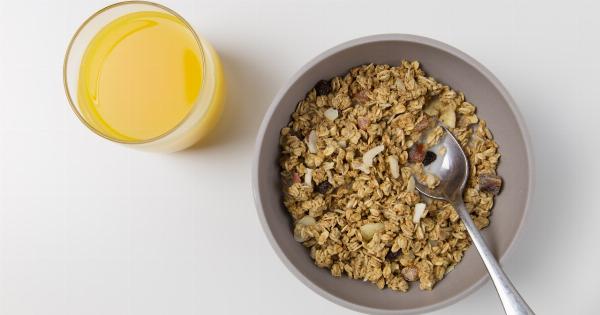After a satisfying meal, many people wonder when it is safe to engage in physical activity.
Whether you enjoy a hearty breakfast, a leisurely lunch, or a delightful dinner, incorporating exercise into your routine can be beneficial for your overall health and well-being. However, the timing of your post-meal exercise plays a crucial role in maximizing its effectiveness and minimizing any potential discomfort.
The Digestive Process
Before diving into the ideal waiting time for post-meal exercise, it is essential to understand the basics of the digestive process. When you consume food, it goes through a series of stages that enable the body to extract nutrients and energy.
These stages typically include ingestion, digestion, absorption, excretion, and defecation.
During the digestion stage, your body breaks down the food into smaller molecules to facilitate absorption.
This process involves the secretion of digestive enzymes, which are responsible for breaking down carbohydrates, proteins, and fats into simpler forms that can be easily absorbed by the body. The nutrients derived from your meal are then transported to various tissues and organs to meet their energy requirements.
Effects of Exercise on Digestion
Engaging in physical activity immediately after a meal can have both positive and negative effects on digestion. On one hand, exercise stimulates the contraction of your muscles, including the muscles surrounding your digestive organs.
This stimulation promotes the movement of food through your digestive tract, leading to enhanced digestion and absorption.
Additionally, exercise increases blood flow to your stomach and intestines, delivering oxygen and nutrients necessary for efficient digestion.
This increased blood flow can also help prevent feelings of sluggishness and bloating that may accompany a large meal.
On the other hand, intense exercise diverts blood flow away from the digestive system and towards the working muscles. This can compromise digestion and result in discomfort, such as stomach cramps, nausea, or diarrhea.
Therefore, finding the right balance is key to reaping the benefits of post-meal exercise while avoiding any potential adverse effects.
Wait Time Recommendations
The general consensus among experts is to wait at least 30 minutes to one hour after a meal before engaging in moderate-intensity exercise.
This time frame allows for adequate digestion and absorption of nutrients without compromising your workout or causing discomfort.
If your meal was particularly large or heavy in fat and protein, you might consider waiting even longer, up to two to three hours, before exercising.
These macronutrients take more time to digest compared to carbohydrates and can lead to a feeling of heaviness or sluggishness if physical activity is initiated too soon.
It’s important to listen to your body and pay attention to any signs of discomfort or digestive distress. If you experience symptoms like stomach pain, indigestion, or acid reflux, postpone your exercise session until you feel better.
Opting for gentle activities like walking or stretching during this time can help promote digestion without overtaxing your system.
It’s worth noting that individual responses to post-meal exercise may vary. Some people may tolerate exercising soon after a meal with no issues, while others may need a longer waiting period.
Experimenting with different wait times and observing how your body responds can help you determine the optimal timeframe for your post-meal exercise routine.
Suggestions for Post-Meal Exercise
While it’s important to wait the appropriate amount of time before exercising after a meal, the type and intensity of physical activity can also impact your overall experience. Here are some suggestions for post-meal exercise:.
1. Walking
Walking is a gentle yet effective form of exercise that can be done at any time of the day, including after a meal.
Taking a leisurely walk for 15-20 minutes can aid digestion and help prevent blood sugar spikes, especially after consuming a high-carbohydrate meal.
2. Yoga or Stretching
Engaging in gentle yoga poses or performing stretching exercises is a great way to promote blood flow, relieve any muscle tension, and aid digestion.
Avoid intense flows or stretches that put too much pressure on your abdomen, as this might lead to discomfort.
3. Low-Impact Cardiovascular Exercise
Opt for low-impact cardiovascular exercises like cycling, swimming, or using an elliptical machine. These activities provide a moderate-intensity workout without excessive strain on your digestive system.
4. Resistance Training
If you enjoy weightlifting or resistance training, consider focusing on exercises that engage your upper body rather than intense core exercises.
This approach helps to minimize any discomfort that may arise from having a full stomach while still allowing you to engage in post-meal exercise.
5. Mindful Movement
Practicing mindful movements such as tai chi or qigong can help you connect with your body, improve digestion, and promote a sense of calmness. These activities are gentle and can be performed after a meal without causing any adverse effects.
The Impact of Specific Foods on Exercise Timing
Certain foods can have a more significant impact on digestion time and exercise readiness. Here’s a breakdown of some common types of food and the waiting time they may necessitate:.
1. High-Fiber Foods
Foods rich in fiber, such as fruits, vegetables, whole grains, and legumes, require more time to digest compared to low-fiber foods.
Waiting at least 60 minutes after consuming a high-fiber meal is recommended to avoid any potential discomfort during exercise.
2. Fatty Meals
Meals high in fat can delay gastric emptying, meaning the time it takes for food to leave your stomach and enter the small intestine. A longer waiting period of two to three hours is advisable before engaging in physical activity after a high-fat meal.
3. Protein-Rich Foods
Protein-rich meals, such as lean meats, beans, and dairy products, require more time for digestion compared to carbohydrates.
Waiting for approximately one to two hours after consuming a protein-rich meal allows for proper digestion and reduces the risk of any discomfort during exercise.
4. Simple Carbohydrates
Foods high in simple carbohydrates, such as refined grains and sugary snacks, are quickly broken down and absorbed by the body.
Waiting for a shorter duration of 30 minutes to one hour is generally sufficient before engaging in exercise after consuming simple carbohydrates.
Conclusion
Post-meal exercise can be a valuable addition to your routine, helping to improve digestion, increase energy levels, and promote overall well-being.
However, finding the optimal waiting time before exercising is important to avoid any potential discomfort or adverse effects on digestion. Waiting for 30 minutes to one hour after a meal is generally recommended, but individual responses may vary. It’s essential to listen to your body and adjust the timing to suit your needs.
Remember to choose low-impact activities initially and gradually increase intensity based on your comfort level. By striking the right balance, you’ll be able to enjoy the benefits of post-meal exercise without compromising your digestive health.




























